Interlayer Adhesion of Coating System in Analogue and Digital Printing Technologies Formed on Lightweight Honeycomb Furniture Panels
Abstract
1. Introduction
2. Materials and Methods
2.1. Substrate and Coating Products
2.2. Research Method
2.2.1. Visual Assessment
2.2.2. Contact Angle
2.2.3. Measurements of Surface Energy
- Series 24, 26 28, 30, 32, 34, 36, 38, 40, 42, 44, 46, 48, 50, 54, 58, 62, 66, and 72 mN/m.
2.2.4. Adhesion Strength of Coatings
3. Results
3.1. Visual Assessment
3.2. Contact Angle
3.3. Measurements of Surface Energy
Measurements of Surface Energy by Ink Stripes
3.4. Adhesion Strength
4. Conclusions
- Stage I: Samples 3 and 4. The first layer of sealer was applied directly onto the HDF board substrate. Both variants exhibit similarly acceptable properties as a base layer for the second layer of sealer (minimum recommended energy density: UVA 89.0 mJ/m2; UVV 85.6 mJ/m2).
- Stage II: Samples 7 and 9. The second layer of sealer was applied onto the first sealer. Both variants exhibit similarly acceptable properties as a base layer for the first base coat (minimum recommended energy density: UVA 113.2 mJ/m2; UVV 110.2 mJ/m2).
- Stage III: Sample 27. The first layer builds a colour by first applying a 12 g/m2 coloured base coat (recommended energy density: LED395 nm 346.0 mJ/cm2).
- Stage IV: Sample 27A. The first layer builds a colour by first applying a 30 g/m2 coloured base coat. This is preferred for cases requiring an intense colour coverage, hardened with an energy density of LED395 nm > 346.0 mJ/cm2.
- Stage V: Sample 42 (for analogue and digital printing). The second base coat consists of 30 g/m2. It can be used as a background for analogue and digital printing technologies. For the curing process, the use of both types of emitters is necessary (UVA 90.5 mJ/m2; UVV 91.9 mJ/m2; LED395 nm 513.4 mJ/m2).
- Stage VI: Sample 58. The third base coat is created by applying 5 g/m2. This layer is preferred as the optimal background for digital printing due to greater control over surface free energy. For the curing process, only a mercury lamp is sufficient (UVA 99.2 mJ/m2; UVV 99.0 mJ/m2). Regarding adhesion for digital printing, layouts 56 and 57 also scored well; however, there were problems with their print quality (graininess).
Author Contributions
Funding
Institutional Review Board Statement
Informed Consent Statement
Data Availability Statement
Conflicts of Interest
References
- Pawlak, D.; Boruszewski, P. Digital printing in wood industry. Ann. WULS For. Wood Technol. 2020, 109, 109–115. [Google Scholar] [CrossRef]
- Hagedorn, L.; Kremer, G.; Stark, R. Strengthening Aesthetic Individualization in Product Design to Enhance Customer Loyalty and Sustainability. In EcoDesign and Sustainability II; Springer: Berlin/Heidelberg, Germany, 2020. [Google Scholar]
- Altun, S.; Köse, D. Some of the Physical Properties of UV Jet Printed Furniture Surfaces. Drv. Ind. 2013, 64, 39–43. [Google Scholar] [CrossRef][Green Version]
- Feng, X.; Wu, Z.; Ruijuan, S.; Fei, W.; Yayuan, Z.; Meijin, W. Surface Design of Wood-Based Board to Imitate Wood Texture Using 3D Printing Technology. Bioresources 2019, 14, 8196–8211. [Google Scholar] [CrossRef]
- Sang, R.; Manley, A.; Wu, Z.; Feng, X. Digital 3D Wood Texture: UV-Curable Inkjet Printing on Board Surface. Coatings 2020, 10, 1144. [Google Scholar] [CrossRef]
- Mendes, C.; Oliveira, J.; Etxebarria, I.; Vilas, J. Lanceros-Méndez, S. State-of-the-Art and Future Challenges of UV Curable Polymer-Based Smart Materials for Printing Technologies. Adv. Mater. Technol. 2019, 4, 1800618. [Google Scholar] [CrossRef]
- Angelski, D. Influences of some factors upon the accelerated curing of pigmented polyurethane gloss top-coat by UV irradiation. In Proceedings of the 9th Hardwood Conference, Sopron, Hungary, 30 April 2020; pp. 7–12. [Google Scholar]
- El-Rahman, A.; Saad, E.A.; Aydemir, C.; Özsoy, A.S.; Yenidoğan, S. Drying methods of the printing inks. J. Graph. Eng. Des. 2021, 12, 29–37. [Google Scholar] [CrossRef]
- Patil, R.S.; Thomas, J.; Patil, M.; John, J. To Shed Light on the UV Curable Coating Technology: Current State of the Art and Perspectives. J. Compos. Sci. 2023, 7, 513. [Google Scholar] [CrossRef]
- Proszyk, S. Technologia Tworzyw Drzewnych cz. 2. Wykończanie Powierzchni; WsiP: Warszawa, Poland, 1999; pp. 1–374. [Google Scholar]
- Jašúrek, B.; Vališ, J.; Hozmanová, M. Influence of printing speed and radiation dose on the curing of UV inks and varnishes. In Proceedings of the 9th International Symposium on Graphic Engineering and Design, Novi Sad, Serbia, 8–10 November 2018; pp. 333–339. [Google Scholar] [CrossRef]
- Stowe, R.W. Comparing Traditional UV Systems with LED UV Systems for UV Curing. In Proceedings of the AIMCAL Web Coating & Handling Conference USA the Association of International Metallizers, Coaters & Laminators, Myrtle Beach, SC, USA, 20–22 October 2014. [Google Scholar]
- Khadzhynova, S.; Jakucewicz, S. Sposoby Drukowania Cyfrowego; Politechnika Łódzka: Łódź, Poland, 2016; pp. 1–242. [Google Scholar]
- Ramirez, J.; Tumolva, T. Analysis and optimization of water-based printing ink formulations for polyethylene films. Appl. Adhes. Sci. 2018, 6, 1. [Google Scholar] [CrossRef]
- Tomerlin, R.; Valdec, D.; Tomisa, M.; Vusic, D. The Impact of Underlying Opaque White Coating Parameters on Flexographic Print Quality. Appl. Sci. 2023, 13, 8575. [Google Scholar] [CrossRef]
- UV-LED Curing—Eco-Friendly and Energy-Saving Technology. Available online: https://www.textiletechnology.net/technology/trendreports/STFI-UV-LED-curing-%E2%80%93-eco-friendly-and-energy-saving-technology-for-textile-industry-30338 (accessed on 31 May 2021).
- Rentzhog, M. Characterisation of Water-Based Flexographic Inks and Their Interactions with Polymer-Coated Board. Master’s Thesis, KTH Royal Institute of Technology, Stockholm, Sweden, 2004. [Google Scholar]
- Lis, B.; Proszyk, S.; Krystofiak, T. Low energy consuming of hardening of lacquer coatings by means of UV–LED radiators. Inthercathedra 2009, 25, 75–79. [Google Scholar]
- Borysiuk, P.; Derda, M.; Auriga, R.; Boruszewski, P.; Monder, S. Comparison of Selected Properties of Varnish Coatings Curing with the Use of UV and UV-LED Approach. Ann. Wars. Univ. Life Sci.-SGGW For. Wood Technol. 2015, 92, 49–54. [Google Scholar]
- Landry, V.; Blanchet, P.; Boivin, G.; Bouffard, J.-F.; Vlad, M. UV-LED Curing Efficiency of Wood Coatings. Coatings 2015, 5, 1019–1033. [Google Scholar] [CrossRef]
- Li, T.; Lin, F.; Ji, M.; Huang, B.; Cheng, W.; Shi, L.; Xia, M.; Wang, L. Development and Measurement of a 365 NM UV LED Irradiance Source. Meas. Sens. 2021, 18, 100153. [Google Scholar] [CrossRef]
- Kraśkiewicz, A.; Kowalczyk, A. Radiation Curing of Phosphorus Telomer-Based Coatings Using UV LEDs or Medium-Pressure Mercury Lamp. Materials 2023, 16, 7493. [Google Scholar] [CrossRef]
- Phoseon Technology, Peak Irradiance & Energy Density. A Phoseon Technology White Paper April 2018. Available online: https://www.google.com/url?sa=t&source=web&rct=j&opi=89978449&url=https://phoseon.com/wp-content/uploads/2019/03/Phoseon-White-Paper_April-2018_Power-vs-Irradiance.pdf&ved=2ahUKEwiptdaRwKSHAxUQQ_EDHVFoDmAQFnoECBcQAQ&usg=AOvVaw1PZuQcBMkCJ9I1B36F_835 (accessed on 29 June 2024).
- Phoseon Technology, Dlaczego Całkowita Moc UV Jest Ważna dla Utwardzania UV LED? Świat DRUKU 9/2023, 28. Available online: https://www.google.com/url?sa=t&source=web&rct=j&opi=89978449&url=https://swiatdruku.eu/content/download/61232/614509/version/1/file/Dlaczego%2Bca%25C5%2582kowita%2Bmoc%2BUV%2Bjest%2Bwa%25C5%25BCna%2Bdla%2Butwardzania%2BUV%2BLED.pdf&ved=2ahUKEwi0ysv-jaKHAxXoR_EDHa6aCokQFnoECBUQAQ&usg=AOvVaw1EzGGAtmMQiP4u6M_9zHzN (accessed on 20 May 2024).
- Energy Density Matters … and This is Why. Available online: https://uvebtech.com/articles/2021/energy-density-mattersand-this-is-why/ (accessed on 20 May 2024).
- Kloubek, J. Calculation of surface free energy components of ice according to its wettability by water, chlorbenzene and carbon disulfide. J. Colloid Interface Sci. 1974, 46, 185–190. [Google Scholar] [CrossRef]
- Liptáková, E.; Kúdela, J. Analysis of the Wood-Wetting Process. Holzforschung 1994, 48, 139–144. [Google Scholar] [CrossRef]
- Kúdela, J.; Liptáková, E. Adhesion of coating materials to wood. J. Adhes. Sci. Technol. 2006, 20, 875–895. [Google Scholar] [CrossRef]
- Żenkiewicz, M. Methods for the calculation of surface free energy of solids. J. Achiev. Mater. Manuf. Eng. 2007, 24, 137–145. [Google Scholar]
- Erbil, H. The debate on the dependence of apparent contact angles on drop contact area or three-phase contact line: A review. Surf. Sci. Rep. 2014, 69, 325–365. [Google Scholar] [CrossRef]
- Palencia, M. Surface free energy of solids by contact angle measurements. J. Sci. Technol. Appl. 2017, 2, 84–93. [Google Scholar] [CrossRef]
- Benkreif, R.; Brahmia, F.Z.; Csiha, C. Influence of moisture content on the contact angle and surface tension measured on birch wood surfaces. Eur. J. Wood Prod. 2021, 79, 907–913. [Google Scholar] [CrossRef]
- Aydın, İ. Surface tension, contact angle and wettability of wood. Wood Ind. Eng. 2024, 6, 18–27. [Google Scholar]
- Pecina, H.; Paprzycki, O. Lack auf Holz; Vincentz Verlag: Hannover, Germany, 1995; pp. 1–175. [Google Scholar]
- Lis, B.; Krystofiak, T. Badania adhezji powłok lakierowych do drewna. Maksymalna przyczepność. In Lakiernictwo Przem. Uszlachetnianie Powierzchni Drewna cz.2, Goldman; Goldman: Tczew, Poland, 2010; pp. 44–46. [Google Scholar]
- Sickfeld, J. Pull-Off Test, an Internationally Standardized Method for Adhesion Testing-Assessment of the Relevance of Test Results. In Adhesion Aspects of Polymeric Coatings; Mittal, K.L., Ed.; Springer: Boston, MA, USA, 1983; pp. 543–567. [Google Scholar] [CrossRef]
- Maxwell, A.S. Review of Test Methods for Coating Adhesion. NPL Report No.: MATC(A)49. 2001, Volume 49, pp. 1–47. Available online: http://eprintspublications.npl.co.uk/id/eprint/2077 (accessed on 20 May 2024).
- Dilik, T.; Erdinler, E.; Hazir, E.; Koc, K.; Hiziroglu, S. Adhesion Strength of Wood Based Composites Coated with Cellulosic and Polyurethane Paints. Adv. Mater. Sci. Eng. 2015, 1, 1–5. [Google Scholar] [CrossRef]
- Łach, M.; Róg, G.; Ochman, K.; Pławecka, K.; Bąk, A.; Korniejenko, K. Assessment of Adhesion of Geopolymer and Varnished Coatings by the Pull-Off Method. Eng 2022, 3, 42–59. [Google Scholar] [CrossRef]
- Tokarczyk, M. Layered Cellular Board. Patent Number PL435052A1, 28 February 2022. [Google Scholar]
- Park, J.-W.; Shim, G.-S.; Lee, J.-G.; Jang, S.-W.; Kim, H.-J.; Choi, J.-N. Evaluation of UV Curing Properties of Mixture Systems with Differently Sized Monomers. Materials 2018, 11, 509. [Google Scholar] [CrossRef]
- Nowakowski, P. Badania Migracji Wybranych Fotoinicjatorów (4-PBZ i TPO-L) z Pokrytych Poliakrylowymi Lakierami Opakowań Przeznaczonych do Kontaktu z Żywnością. Ph.D. Thesis, Uniwersytet Marii Curie-Skłodowskiej w Lublinie, Wydział Chemii Instytut Nauk Chemicznych, Lublin, Polska, 2020. [Google Scholar]
- Tao, Y.; Sun, G.; Wei, Y.; Liu, R.; Zhao, J. An anti-shrinkage model of an ultraviolet-curing coating filled with hollow polyurethane acrylate microspheres. Mech. Mater. 2021, 163, 334–339. [Google Scholar] [CrossRef]
- Zhang, H.; Feng, X.; Wu, Y.; Wu, Z. Effect of Photoinitiator Concentration and Film Thickness on the Properties of UV-Curable Self-Matting Coating for Wood-Based Panels. Forests 2023, 14, 1189. [Google Scholar] [CrossRef]
- Moeck, A.; Bianchi, R.; Volker Petry, V.; Weder, R.; Helsby, D. Shrinkage of UV Oligomers and Monomers. Available online: https://www.google.com/url?sa=t&source=web&rct=j&opi=89978449&url=https://www.radtech.org/2014proceedings/papers/technical-conference/Formulation/Moeck%2520-%2520Shrinkage%2520of%2520UV%2520Oligomers%2520and%2520Monomers.pdf&ved=2ahUKEwja6ces2YGIAxUgLBAIHczuFnQQFnoECBwQAQ&usg=AOvVaw1DkP00RyOmmEFRH7GsohiA (accessed on 21 May 2024).
- Bekhta, P.; Lis, B.; Krystofiak, T.; Bekhta, N. Surface Roughness of Varnished Wood Pre-Treated Using Sanding and Thermal Compression. Forests 2022, 13, 777. [Google Scholar] [CrossRef]
- Slabejová, G.; Šmidriaková, M. The effect of coating film thickness on the quality of surface finish on lightweight plywood. Acta Fac. Xylologiae Zvolen 2022, 64, 39–58. [Google Scholar] [CrossRef]
- Tokarczyk, M.; Lis, B.; Salca, E.A.; Krystofiak, T. Adhesion of Varnish Coatings as a Background for Analogue and Digital Printing Technologies. Appl. Sci. 2023, 14, 304. [Google Scholar] [CrossRef]
- Hideo, N.; Ryuichi, I.; Yosuke, H.; Hiroyuki, S. Effects of surface roughness on wettability. Acta Mater. 1998, 46, 2313–2318. [Google Scholar] [CrossRef]
- Żenkiewicz, M. Adhezja i Modyfikowanie Warstwy Wierzchniej Tworzyw Wielkocząsteczkowych; Wydawnictwo Naukowo-Techniczne: Warszawa, Polska, 2000; pp. 81–83. [Google Scholar]
- Kubiak, K.J.; Wilson, M.C.T.; Mathia, T.G.; Carval, P. Wettability versus roughness of engineering surfaces. Wear 2011, 271, 523–528. [Google Scholar] [CrossRef]
- Candan, Z.; Büyüksarı, U.; Korkut, S.; Unsal, O.; Çakıcıer, N. Wettability and Surface Roughness of Thermally Modified Plywood Panels. Ind. Crops Prod. 2012, 36, 434–436. [Google Scholar] [CrossRef]
- Papp, E.; Csiha, C. Contact angle as function of surface roughness of different wood species. Surf. Interfaces 2017, 8, 54–59. [Google Scholar] [CrossRef]
- Yorur, H.; Erer, A.M.; Oğuz, S. Effect of surface roughness on wettability of adhesive on wood substrates. In Proceedings of the 3rd International Conference on Science, Ecology and Technology, Rome, Italy, 14–16 August 2017. [Google Scholar]
- Yuningsih, I.; Rahayu, I.S.; Lumongga, D.; Darmawan, W. Wettability and adherence of acrylic paints on long and short rotation teaks. Wood Mater. Sci. Eng. 2019, 15, 229–236. [Google Scholar] [CrossRef]
- Bartoszuk, K.; Kowaluk, G. The Influence of the Content of Recycled Natural Leather Residue Particles on the Properties of High-Density Fiberboards. Materials 2023, 16, 5340. [Google Scholar] [CrossRef]
- Yu, Q.; Pan, X.; Yang, Z.; Zhang, L.; Cao, J. Effects of the Surface Roughness of Six Wood Species for Furniture Production on the Wettability and Bonding Quality of Coating. Forests 2023, 14, 996. [Google Scholar] [CrossRef]
- Casilla, R.C.; Chow, S.; Steiner, P.R. An immersion technique for studying wood wettability. Wood Sci. Technol. 1981, 15, 31–43. [Google Scholar] [CrossRef]
- Wang, X.F.; Wei, X.F.; Huang, P.Q. Study on Performance of Adherence of Water-Base UV Varnish. Adv. Mater. Res. 2010, 174, 409–412. [Google Scholar] [CrossRef]
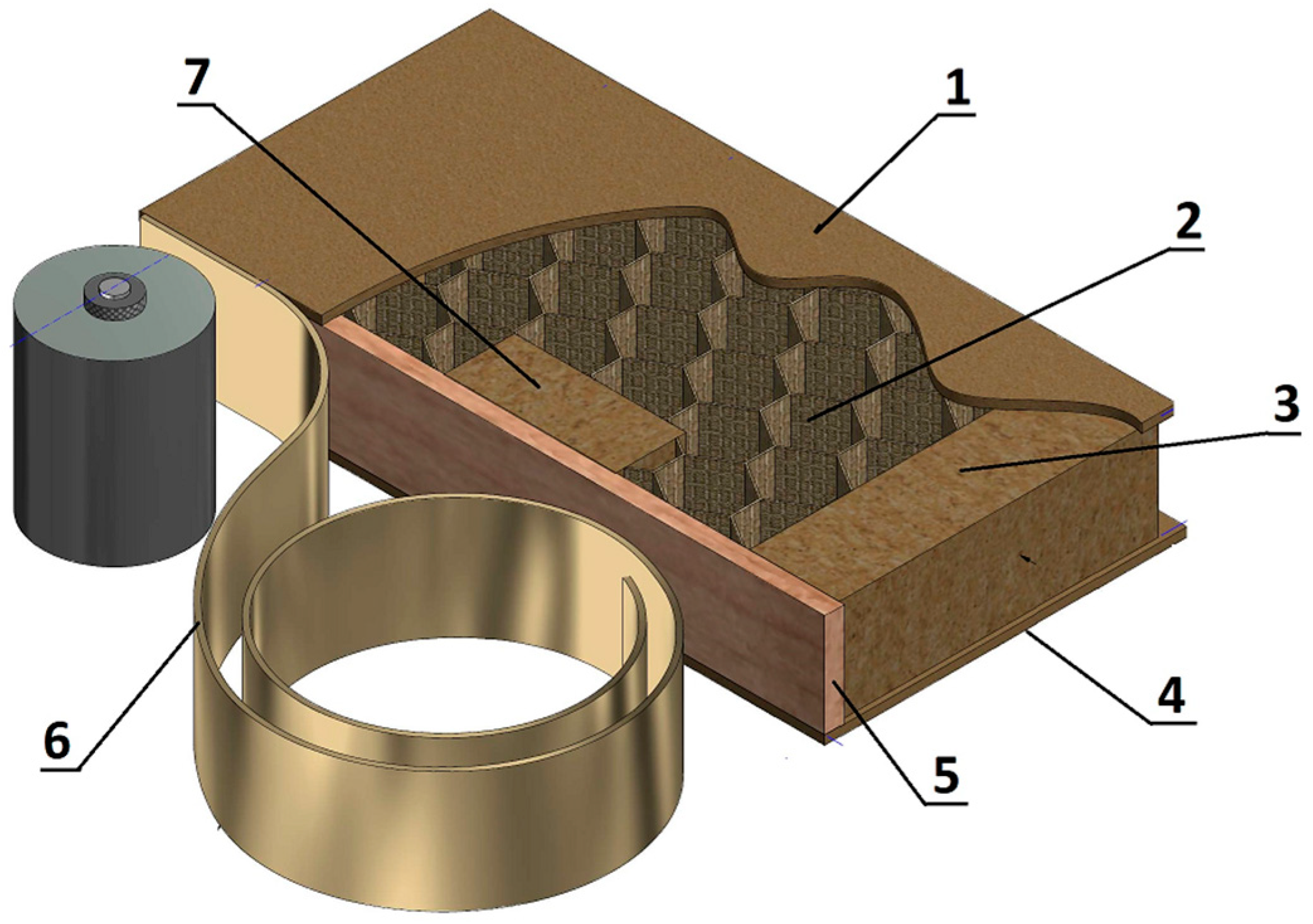


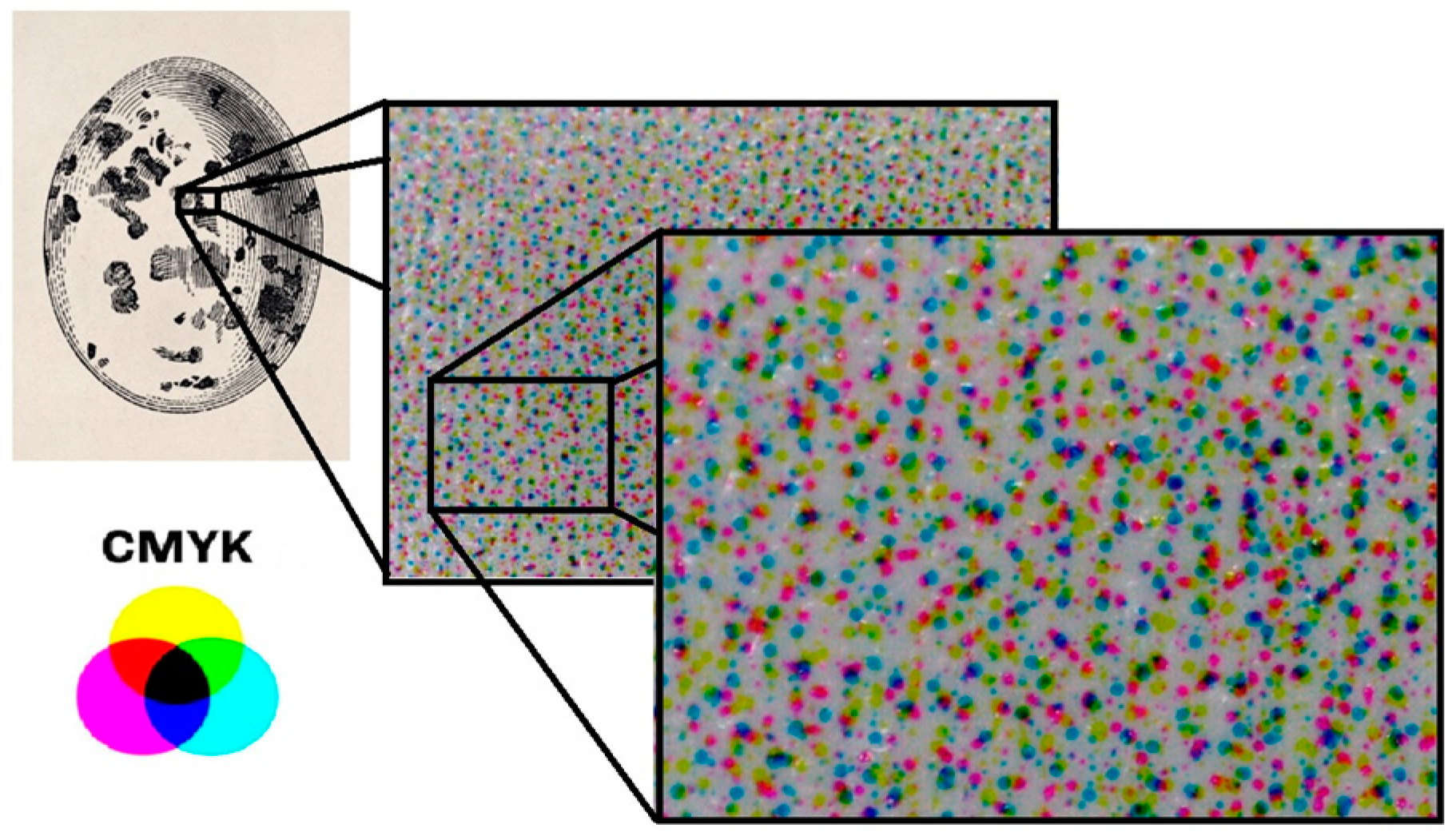
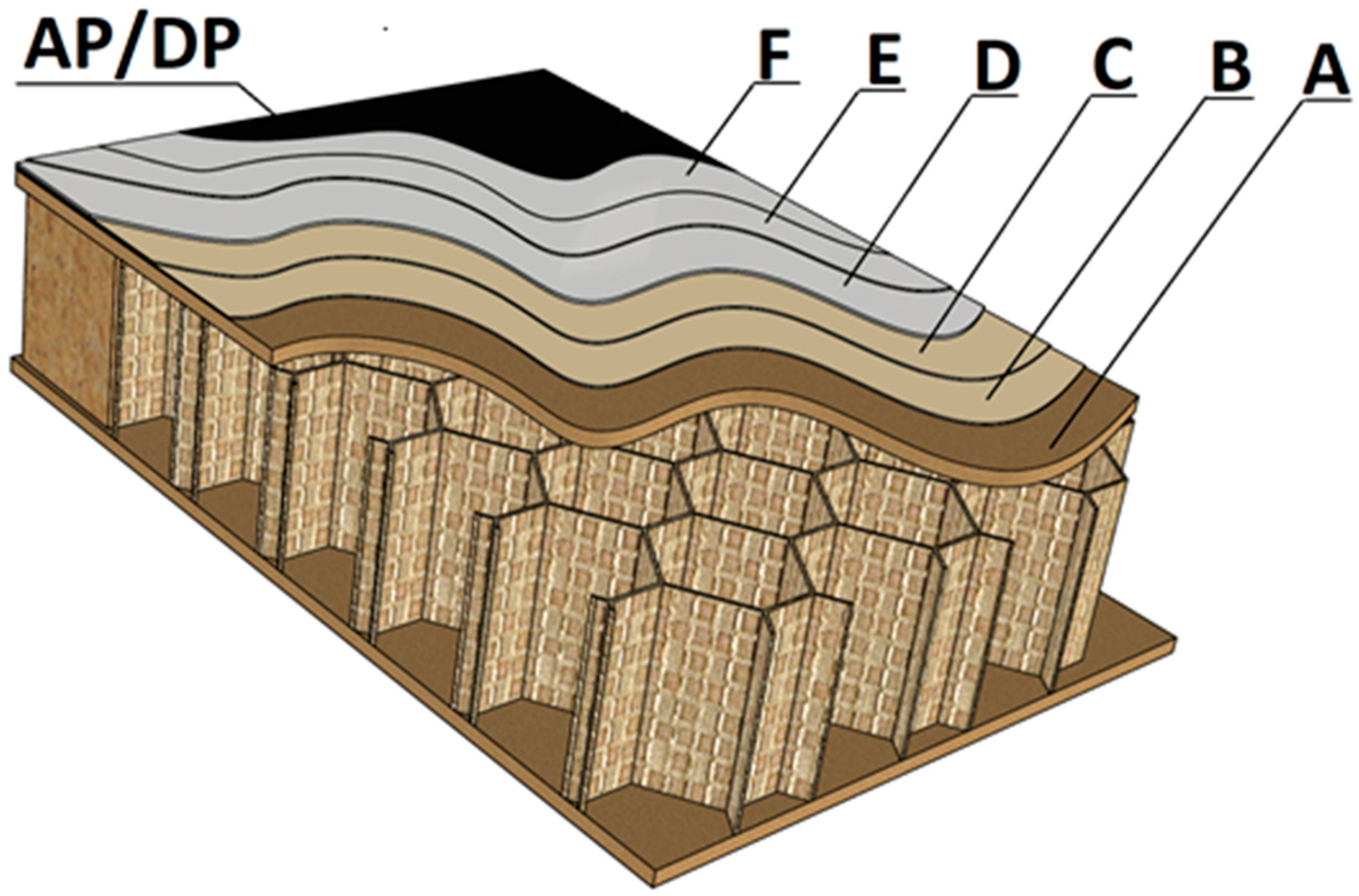

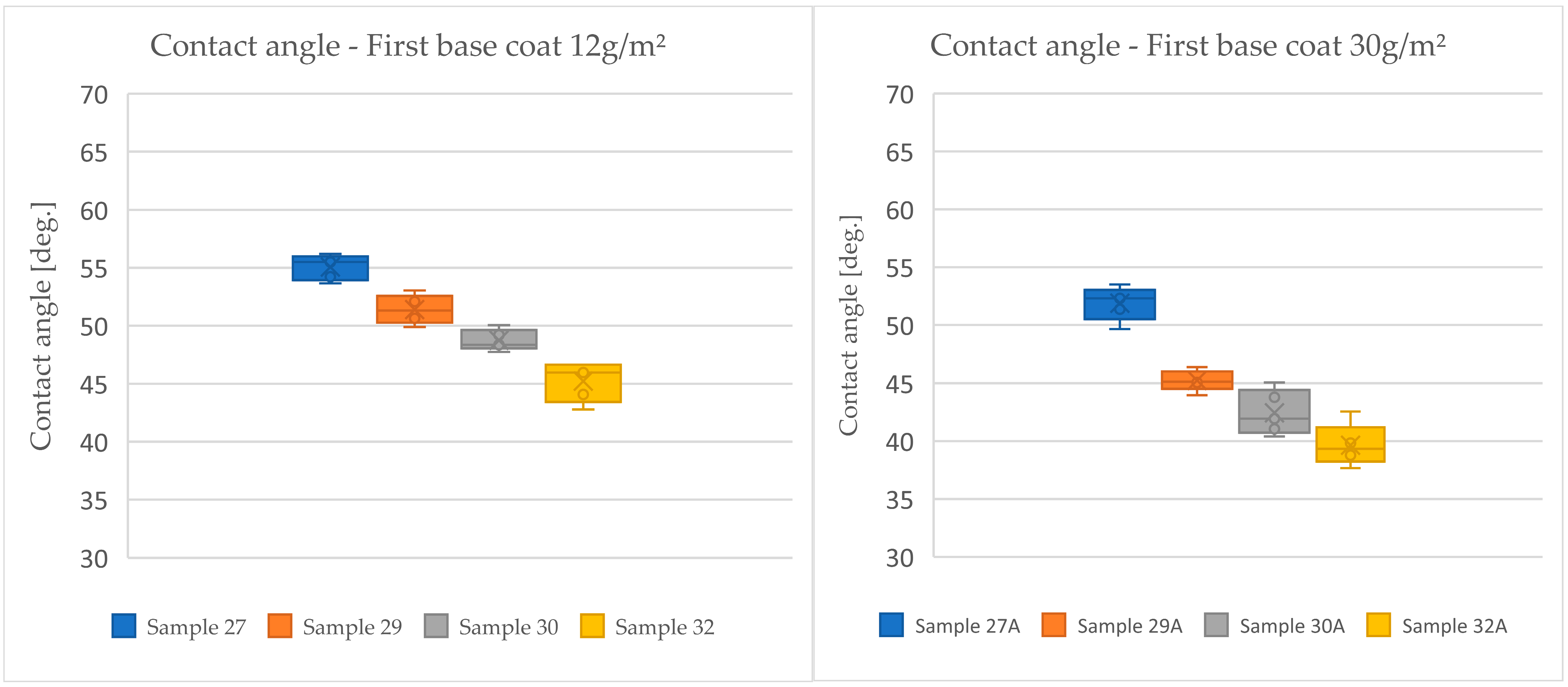

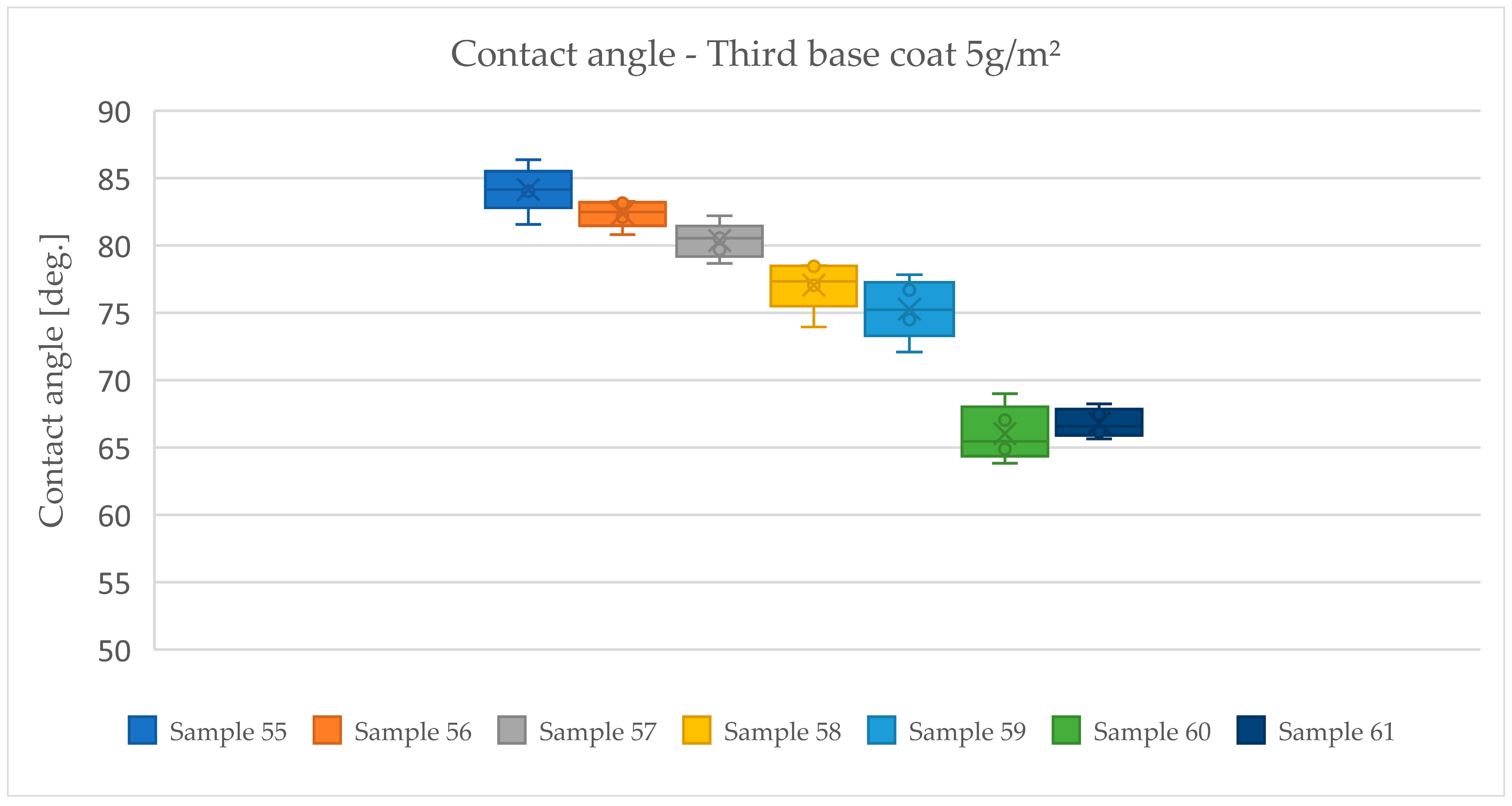

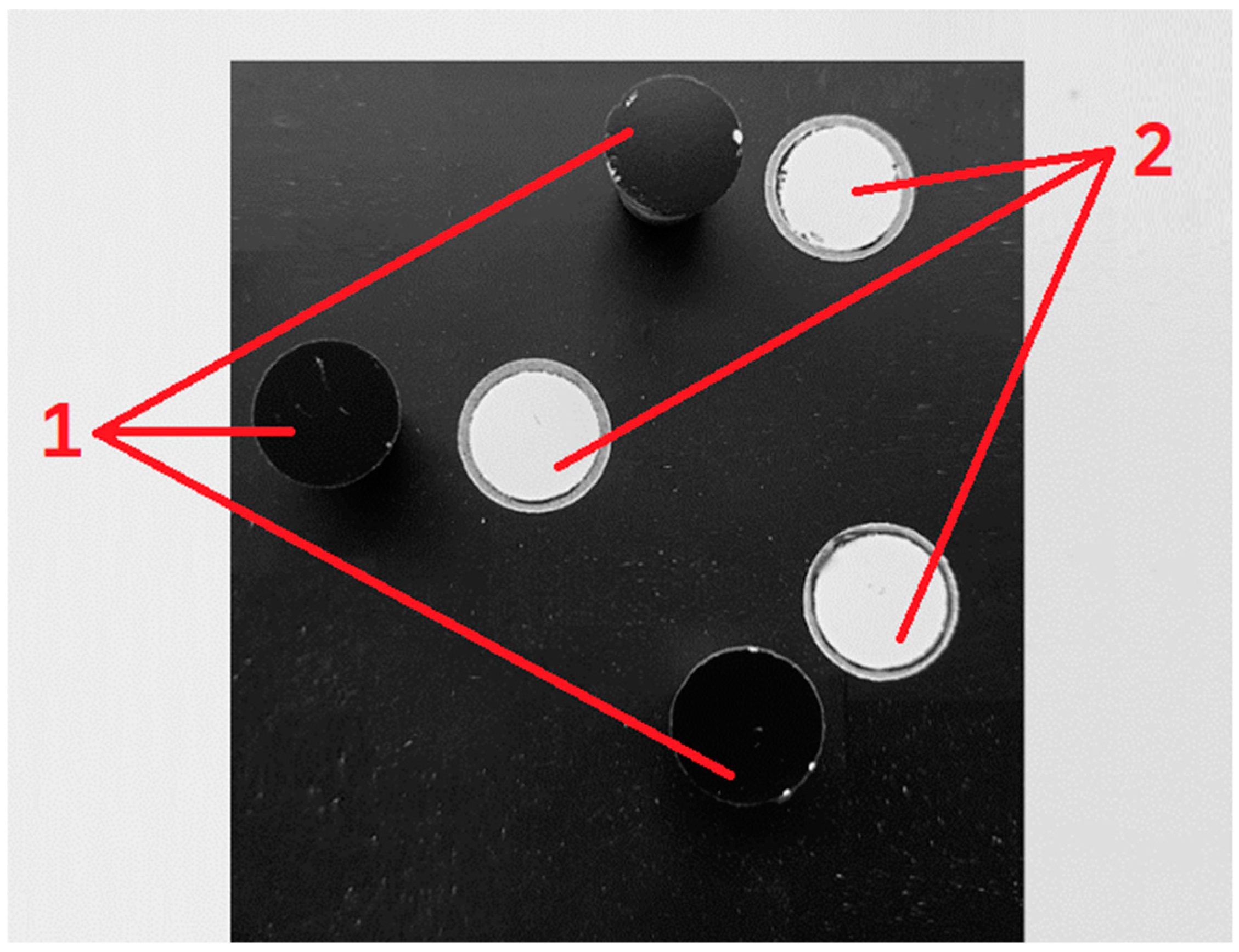
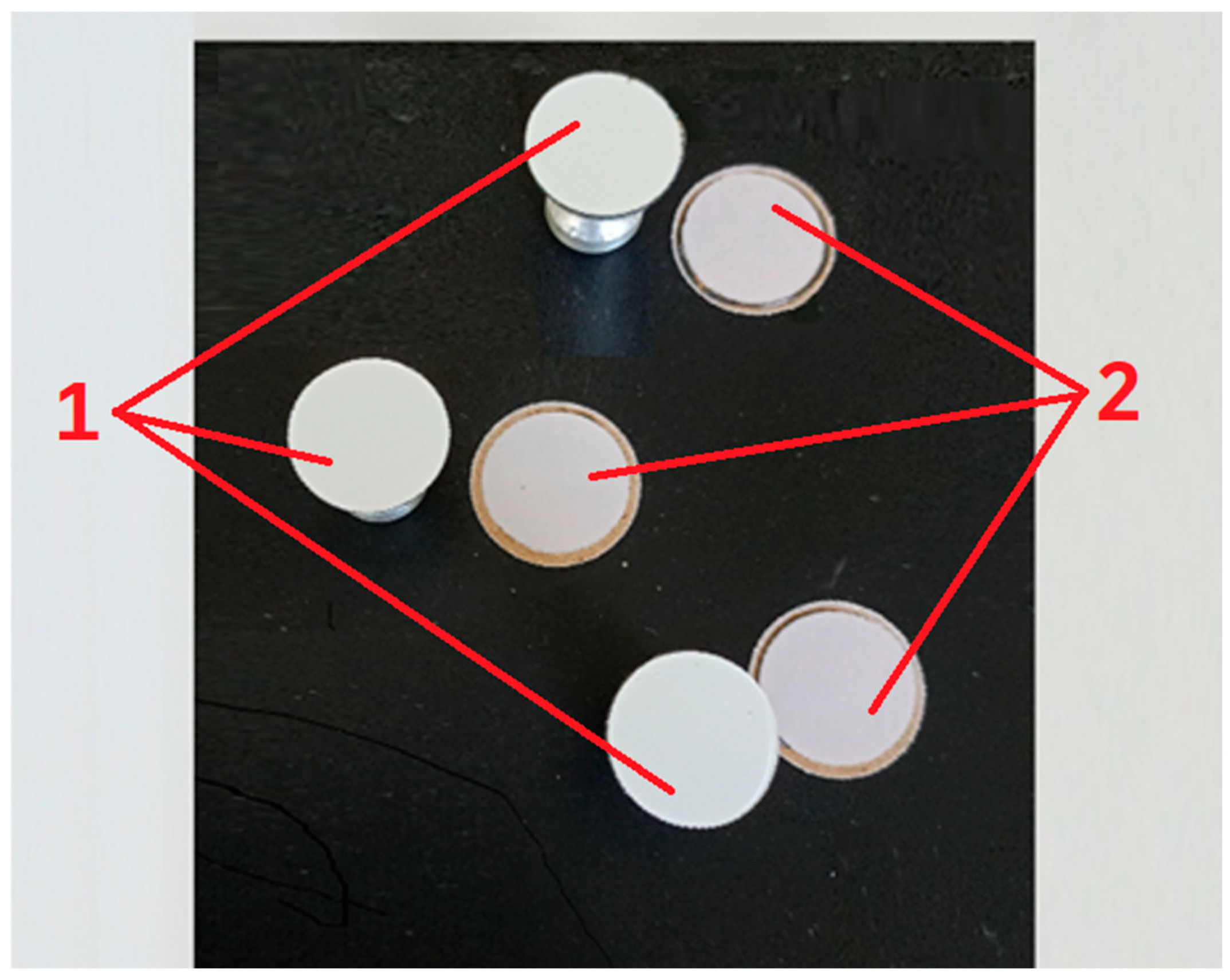
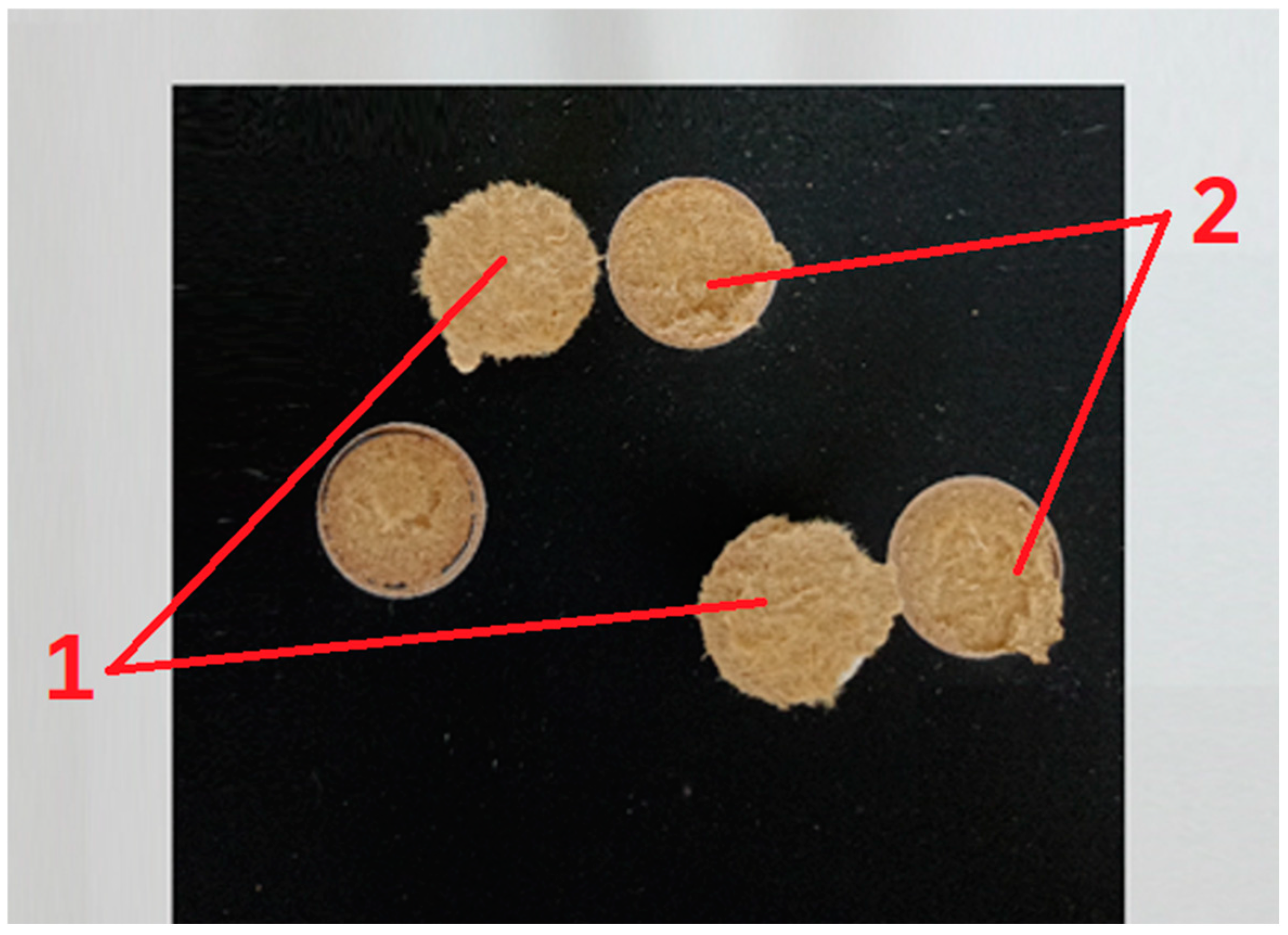
| Name of UV Varnish Products | |||||
|---|---|---|---|---|---|
| Properties | IQ-UV 03040 Sealer | IQ-UVC03284 Basecoat | IQ-UVC03285 Basecoat | Iq-Hyc02486 Ink | ANUVIA 1250 UV Ink |
| Polymer base | acrylic | acrylic | acrylic | waterborne | acrylic |
| Colour | colourless | white | white | black | CMYK |
| Solid content [%] | 95.3 ± 3 | 97.6 ± 3 | 97.5 ± 3 | 20 ± 3 | |
| Viscosity | 65–85 | 90–140 | 35–50 | 20–35 | 15–25 |
| (flow cup 8 mm) | (flow cup 6 mm) | (flow cup 8 mm) | (flow cup 4 mm) | (flow cup 4 mm) | |
| Processing temperature [°C] | Between 20 and 50 | ||||
| Samples | Speed [m/min] | Amount for Layer [g/m2] | Type | Energy UVA [mJ/cm2] | Energy UVV [mJ/cm2] | LED395 nm [mJ/cm2] |
|---|---|---|---|---|---|---|
| Process scheme (Stage I) |  | |||||
| 3 | 40 | 50 | sealer | 114.8 | 111.9 | - |
| 4 | 40 | 50 | sealer | 89.0 | 85.6 | - |
| 5 | 40 | 50 | sealer | 57.4 | 55.9 | - |
| 6 | 40 | 50 | sealer | 26.2 | 26.1 | - |
| Process scheme (Stage II) |  | |||||
| 7 | 40 | 25 | sealer | 171.1 | 164.8 | - |
| 9 | 40 | 25 | sealer | 113.2 | 110.2 | - |
| 10 | 40 | 25 | sealer | 88.9 | 84.7 | - |
| 12 | 40 | 25 | sealer | 26.8 | 26.1 | - |
| Process scheme (Stage III) |  | |||||
| 27 | 40 | 12 | base coat 1 | - | - | 443.9 |
| 29 | 40 | 12 | base coat 1 | - | - | 346.0 |
| 30 | 40 | 12 | base coat 1 | - | - | 288.5 |
| 32 | 40 | 12 | base coat 1 | - | - | 196.1 |
| Process scheme (Stage IV) |  | |||||
| 27A | 40 | 30 | base coat 1A | - | - | 443.9 |
| 29A | 40 | 30 | base coat 1A | - | - | 346.0 |
| 30A | 40 | 30 | base coat 1A | - | - | 288.5 |
| 32A | 40 | 30 | base coat 1A | - | - | 196.1 |
| Process scheme (Stage V) |  | |||||
| 36 | 40 | 30 | base coat 2 | 301.7 | 300.7 | 513.4 |
| 37 | 40 | 30 | base coat 2 | 182.3 | 183.3 | 513.4 |
| 42 | 40 | 30 | base coat 2 | 90.5 | 91.9 | 513.4 |
| 43 | 40 | 30 | base coat 2 | 76.7 | 79.7 | 345.8 |
| 44 | 40 | 30 | base coat 2 | 59.6 | 62.1 | 513.4 |
| 46 | 40 | 30 | base coat 2 | 27.3 | 29.6 | 345.8 |
| 47 | 40 | 30 | base coat 2 | - | - | 345.8 |
| Process scheme (Stage VI) |  | |||||
| 55 | 40 | 5 | base coat 3 | 303.7 | 302.7 | - |
| 56 | 40 | 5 | base coat 3 | 192.5 | 192.7 | - |
| 57 | 40 | 5 | base coat 3 | 150.1 | 150.2 | - |
| 58 | 40 | 5 | base coat 3 | 99.2 | 99.0 | - |
| 59 | 40 | 5 | base coat 3 | 64.3 | 64.1 | - |
| 60 | 40 | 5 | base coat 3 | 34.0 | 31.9 | - |
| 61 | 40 | 5 | base coat 3 | 34.0 | 31.9 | 225.9 |
| Detachment Type | Detachment Occurring in a Given System |
|---|---|
| A | Cohesive in a substrate |
| A/B | Adhesive between a substrate and the first sealer |
| B | Cohesive in the first sealer |
| B/C | Adhesive between the first sealer and second sealer |
| C | Cohesive in the second sealer |
| C/D | Adhesive between the second sealer and first base coat |
| D | Cohesive in the first base coat |
| D/E | Adhesive between the first base coat and second base coat |
| E | Cohesive in the second base coat |
| E/F | Adhesive between the second base coat and third base coat |
| F | Cohesive in the third base coat |
| E/AP or DP | Adhesive between the second base coat and printings |
| F/AP or DP | Adhesive between the second base coat and printings |
| AP | Cohesive in the analogue printings |
| DP | Cohesive in the digital printings |
| Marking of Samples | Speed [m/min] | Amount for Last Layer [g/m2] | Kind of Lacquer Product | Mean of Contact Angle [degrees] | Max. | Min. | Standard Deviation | Coefficient of Variation [%] |
|---|---|---|---|---|---|---|---|---|
| 3 | 40 | 50 | sealer | 60.8 | 63.3 | 57.5 | 2.4 | 3.87 |
| 4 | 40 | 50 | sealer | 57.8 | 58.5 | 56.1 | 1.0 | 1.76 |
| 5 | 40 | 50 | sealer | 51.1 | 53.3 | 49.7 | 1.4 | 2.65 |
| 6 | 40 | 50 | sealer | 43.8 | 45.1 | 41.7 | 1.3 | 2.90 |
| 7 | 40 | 25 | sealer 2 | 64.1 | 66.7 | 61.7 | 1.9 | 2.89 |
| 9 | 40 | 25 | sealer 2 | 62.7 | 65.4 | 58.5 | 2.8 | 4.53 |
| 10 | 40 | 25 | sealer 2 | 61.6 | 63.8 | 59.8 | 2.0 | 3.23 |
| 12 | 40 | 25 | sealer 2 | 57.7 | 59.7 | 55.5 | 1.6 | 2.72 |
| 27 | 40 | 12 | base coat 1 | 55.1 | 56.2 | 53.7 | 1.1 | 1.97 |
| 29 | 40 | 12 | base coat 1 | 51.4 | 53.1 | 49.9 | 1.2 | 2.40 |
| 30 | 40 | 12 | base coat 1 | 48.7 | 50.1 | 47.7 | 0.9 | 1.85 |
| 32 | 40 | 12 | base coat 1 | 45.2 | 46.7 | 42.8 | 1.7 | 3.81 |
| 27A | 40 | 30 | base coat 1A | 51.9 | 53.5 | 49.7 | 1.5 | 2.82 |
| 29A | 40 | 30 | base coat 1A | 45.2 | 46.4 | 44.0 | 0.9 | 1.96 |
| 30A | 40 | 30 | base coat 1A | 42.5 | 45.1 | 40.4 | 1.9 | 4.57 |
| 32A | 40 | 30 | base coat 1A | 39.6 | 42.6 | 37.7 | 1.8 | 4.59 |
| 36 | 40 | 30 | base coat 2 | 89.9 | 92.3 | 87.7 | 1.7 | 1.85 |
| 37 | 40 | 30 | base coat 2 | 83.3 | 84.8 | 81.0 | 1.6 | 1.91 |
| 42 | 40 | 30 | base coat 2 | 77.0 | 79.0 | 75.3 | 1.4 | 1.77 |
| 43 | 40 | 30 | base coat 2 | 75.3 | 76.4 | 73.8 | 0.9 | 1.26 |
| 44 | 40 | 30 | base coat 2 | 71.4 | 73.4 | 69.8 | 1.3 | 1.84 |
| 46 | 40 | 30 | base coat 2 | 61.3 | 63.5 | 58.8 | 1.9 | 3.07 |
| 47 | 40 | 30 | base coat 2 | 54.3 | 55.9 | 52.2 | 1.4 | 2.56 |
| 55 | 40 | 5 | base coat 3 | 84.1 | 86.4 | 81.6 | 1.7 | 2.05 |
| 56 | 40 | 5 | base coat 3 | 82.4 | 83.3 | 80.8 | 1.0 | 1.20 |
| 57 | 40 | 5 | base coat 3 | 80.4 | 82.2 | 78.7 | 1.3 | 1.63 |
| 58 | 40 | 5 | base coat 3 | 77.5 | 78.5 | 76.0 | 1.1 | 1.38 |
| 59 | 40 | 5 | base coat 3 | 75.3 | 77.8 | 72.1 | 2.2 | 2.92 |
| 60 | 40 | 5 | base coat 3 | 65.3 | 67.0 | 63.8 | 1.2 | 1.78 |
| 61 | 40 | 5 | base coat 3 | 66.8 | 68.2 | 65.6 | 1.0 | 1.55 |
| Samples | Speed [m/min] | Amount for Last Layer [g/m2] | Type | γs | γsd | γsp |
|---|---|---|---|---|---|---|
| [mJ/m2] | ||||||
| 3 | 40 | 50 | sealer | 46.96 | 32.79 | 14.17 |
| 4 | 40 | 50 | sealer | 48.72 | 32.70 | 16.02 |
| 5 | 40 | 50 | sealer | 52.67 | 32.16 | 20.51 |
| 6 | 40 | 50 | sealer | 56.91 | 31.09 | 25.82 |
| 7 | 40 | 25 | sealer 2 | 45.02 | 32.78 | 12.25 |
| 9 | 40 | 25 | sealer 2 | 45.84 | 32.80 | 13.05 |
| 10 | 40 | 25 | sealer 2 | 46.37 | 32.80 | 13.57 |
| 12 | 40 | 25 | sealer 2 | 48.78 | 32.70 | 16.08 |
| 27 | 40 | 12 | base coat 1 | 50.32 | 32.54 | 17.78 |
| 29 | 40 | 12 | base coat 1 | 52.50 | 32.20 | 20.30 |
| 30 | 40 | 12 | base coat 1 | 54.08 | 31.86 | 22.22 |
| 32 | 40 | 12 | base coat 1 | 56.11 | 31.33 | 24.78 |
| 27A | 40 | 30 | base coat 1A | 52.20 | 32.25 | 19.95 |
| 29A | 40 | 30 | base coat 1A | 56.11 | 31.33 | 24.78 |
| 30A | 40 | 30 | base coat 1A | 57.65 | 30.86 | 26.80 |
| 32A | 40 | 30 | base coat 1A | 59.28 | 30.29 | 28.99 |
| 36 | 40 | 30 | base coat 2 | 30.91 | 28.66 | 2.25 |
| 37 | 40 | 30 | base coat 2 | 34.17 | 30.26 | 3.90 |
| 42 | 40 | 30 | base coat 2 | 37.56 | 31.51 | 6.05 |
| 43 | 40 | 30 | base coat 2 | 38.50 | 31.78 | 6.72 |
| 44 | 40 | 30 | base coat 2 | 40.92 | 32.32 | 8.60 |
| 46 | 40 | 30 | base coat 2 | 46.66 | 32.80 | 13.87 |
| 47 | 40 | 30 | base coat 2 | 50.67 | 32.49 | 18.18 |
| 55 | 40 | 5 | base coat 3 | 33.85 | 30.13 | 3.72 |
| 56 | 40 | 5 | base coat 3 | 34.75 | 30.51 | 4.24 |
| 57 | 40 | 5 | base coat 3 | 35.82 | 30.92 | 4.89 |
| 58 | 40 | 5 | base coat 3 | 37.28 | 31.42 | 5.86 |
| 59 | 40 | 5 | base coat 3 | 38.61 | 31.81 | 6.81 |
| 60 | 40 | 5 | base coat 3 | 44.21 | 32.73 | 11.48 |
| 61 | 40 | 5 | base coat 3 | 43.45 | 32.67 | 10.78 |
| Samples | Speed [m/min] | Amount for Last Layer [g/m2] | Type | Evaluation of Test Inks [mJ/m2] |
|---|---|---|---|---|
| 3 | 40 | 50 | sealer | 42–44 |
| 4 | 40 | 50 | sealer | 42–44 |
| 5 | 40 | 50 | sealer | 52–54 |
| 6 | 40 | 50 | sealer | 52–54 |
| 7 | 40 | 25 | sealer 2 | 42–44 |
| 9 | 40 | 25 | sealer 2 | 42–44 |
| 10 | 40 | 25 | sealer 2 | 42–44 |
| 12 | 40 | 25 | sealer 2 | 42–44 |
| 27 | 40 | 12 | base coat 1 | 46–48 |
| 29 | 40 | 12 | base coat 1 | 46–48 |
| 30 | 40 | 12 | base coat 1 | 52–54 |
| 32 | 40 | 12 | base coat 1 | 52–54 |
| 27A | 40 | 30 | base coat 1A | 46–48 |
| 29A | 40 | 30 | base coat 1A | 46–48 |
| 30A | 40 | 30 | base coat 1A | 46–48 |
| 32A | 40 | 30 | base coat 1A | 52–54 |
| 36 | 40 | 30 | base coat 2 | 28–30 |
| 37 | 40 | 30 | base coat 2 | 30–32 |
| 42 | 40 | 30 | base coat 2 | 36–38 |
| 43 | 40 | 30 | base coat 2 | 36–38 |
| 44 | 40 | 30 | base coat 2 | 46–48 |
| 46 | 40 | 30 | base coat 2 | 52–54 |
| 47 | 40 | 30 | base coat 2 | 56–58 |
| 55 | 40 | 5 | base coat 3 | 28–30 |
| 56 | 40 | 5 | base coat 3 | 30–32 |
| 57 | 40 | 5 | base coat 3 | 38–40 |
| 58 | 40 | 5 | base coat 3 | 38–40 |
| 59 | 40 | 5 | base coat 3 | 38–40 |
| 60 | 40 | 5 | base coat 3 | 50–52 |
| 61 | 40 | 5 | base coat 3 | 50–52 |
| Samples | Speed [m/min] | Amount for Last Layer [g/m2] | Type | Evaluation of Adhesion | ||||
|---|---|---|---|---|---|---|---|---|
| 3 | 40 | 50 | sealer | 100A | 100A | 100A | 100A | 100A |
| 4 | 40 | 50 | sealer | 80A, 20A/B | 100A | 100A | 100A | 80A, 20A/B |
| 5 | 40 | 50 | sealer | 60A, 40A/B | 25A, 75A/B | 40A, 60A/B | 60A, 40A/B | 40A, 60A/B |
| 6 | 40 | 50 | sealer | 80A, 20A/B | 70A, 30A/B | 30A, 70A/B | 40A, 60A/B | 20A, 80A/B |
| 7 | 40 | 25 | sealer 2 | 100A | 100A | 100A | 100A | 100A |
| 9 | 40 | 25 | sealer 2 | 100A | 100A | 100A | 95A, 5A/B | 90A, 5B, 5A/B |
| 10 | 40 | 25 | sealer 2 | 80A, 20C | 85A, 15C | 90A, 10C | 85A, 15C | 85A, 15C |
| 12 | 40 | 25 | sealer 2 | 70A, 30C | 85A, 5C, 10B/C | 85A, 10C, 5B/C | 70A, 30C | 95A, 5B/C |
| 27 | 40 | 12 | base coat 1 | 100A | 90A, 10A/B | 100A | 70A, 30A/B | 100A |
| 29 | 40 | 12 | base coat 1 | 70A, 30A/B | 50A, 50A/B | 100A | 90A, 10A/B | 100A |
| 30 | 40 | 12 | base coat 1 | 20A, 80C/D | 100C/D | 15A, 85C/D | 15A, 85C/D | 25A, 75C/D |
| 32 | 40 | 12 | base coat 1 | 100C/D | 100C/D | 100C/D | 100C/D | 100C/D |
| 27A | 40 | 30 | base coat 1A | 100A | 100A, 10A/B | 100A | 70A, 30A/B | 80A, 20A/B |
| 29A | 40 | 30 | base coat 1A | 70A, 30A/B | 30A, 70A/B | 100A/B | 100A/B | 100A/B |
| 30A | 40 | 30 | base coat 1A | 100C/D | 100A/B | 15A, 85C/D | 15A, 85C/D | 25A, 75D |
| 32A | 40 | 30 | base coat 1A | 100C/D | 100C/D | 100C/D | 100C/D | 100C/D |
| Last layers with analogue printings | ||||||||
| 36 | 40 | 30 | base coat 2 | 100E/AP | 100E/AP | 100E/AP | 100E/AP | 100E/AP |
| 37 | 40 | 30 | base coat 2 | 100E/AP | 100E/AP | 10A, 90E/AP | 20A80E/AP | 100E/AP |
| 42 | 40 | 30 | base coat 2 | 70A, 30E/AP | 100A | 90A, 10A/B | 100A | 100A |
| 43 | 40 | 30 | base coat 2 | 70F, 20A, A/B | 70A, 30A/B | 100E | 100F | 5A, 95E |
| 44 | 40 | 30 | base coat 2 | 100D/E | 20A, 80E | 10A, 90D/E | 100D/E | 100D/E |
| 46 | 40 | 30 | base coat 2 | 100D/E | 100D/E | 100D/E | 100D/E | 90E, 10D/E |
| 47 | 40 | 30 | base coat 2 | 100D/E | 100D/E | 100D/E | 100D/E | 100D/E |
| 55 | 40 | 5 | base coat 3 | 100F/AP | 10A, 90F/AP | 100F/AP | 100F/AP | 100F/AP |
| 56 | 40 | 5 | base coat 3 | 100A | 95A, 5B/C | 100F/AP | 95A, 5A/B | 100A |
| 57 | 40 | 5 | base coat 3 | 100A | 95A, 5B/C | 100A | 100A | 100A |
| 58 | 40 | 5 | base coat 3 | 100A | 95A, 5B/C | 100A | 95A, 5B/C | 100A |
| 59 | 40 | 5 | base coat 3 | 100A | 90A, 10A/B | 80A, 20A/B | 100A | 100A |
| 60 | 40 | 5 | base coat 3 | 75A, 25A/B | 100A | 100A | 95A, 5A/B | 100A |
| 61 | 40 | 5 | base coat 3 | 80A, 20A/B | 75A, 25A/B | 80A, 20A/B | 80A, 20A/B | 75A, 25A/B |
| Last layers with digital printings | ||||||||
| 36 | 40 | 30 | base coat 2 | 100E/DP | 10A, 90E/DP | 100E/DP | 100E/DP | 100E/DP |
| 37 | 40 | 30 | base coat 2 | 25A, 75 | 90E/DP | 75A, 25E | 90E/10DP | 10A, 90E/DP |
| 42 | 40 | 30 | base coat 2 | 30A, 75A/B | 100A | 100A | 90A, 10A/B | 100A |
| 43 | 40 | 30 | base coat 2 | 5A, 95EE | 5A, 95EE | 20A, 80A/B | 5A, 95E | 100E |
| 44 | 40 | 30 | base coat 2 | 100D/E | 20A, 80E | 10A, 90D/E | 100D/E | 100D/E |
| 46 | 40 | 30 | base coat 2 | 100D/E | 100D/E | 100D/E | 100D/E | 90E, 10D/E |
| 47 | 40 | 30 | base coat 2 | 100D/E | 100D/E | 100D/E | 100D/E | 100D/E |
| 55 | 40 | 5 | base coat 3 | 10A, 90F/DP | 10A, 90F/DP | 10A, 90F/DP | 30A, 70F/DP | 100F/DP |
| 56 | 40 | 5 | base coat 3 | 100A | 100B/C | 95A, 5B/C | 100B/C | 100B/C |
| 57 | 40 | 5 | base coat 3 | 95B/C, 5C | 95B/C, 5C | 95B/C, 5C | 95B/C, 5C | 95B/C, 5C |
| 58 | 40 | 5 | base coat 3 | 95A, 5A/B | 100A | 95A, 5B/C | 100A | 100A |
| 59 | 40 | 5 | base coat 3 | 85A, 15A/B | 100A | 100A | 85A, 15A/B | 100A |
| 60 | 40 | 5 | base coat 3 | 45A, 55A/B | 85A, 15A/B | 85A, 15A/B | 95A, 5A/B | 95A, 5A/B |
| 61 | 40 | 5 | base coat 3 | 75A, 25A/B | 95A, 5A/B | 100A | 100A | 90A, 10A/B |
Disclaimer/Publisher’s Note: The statements, opinions and data contained in all publications are solely those of the individual author(s) and contributor(s) and not of MDPI and/or the editor(s). MDPI and/or the editor(s) disclaim responsibility for any injury to people or property resulting from any ideas, methods, instructions or products referred to in the content. |
© 2024 by the authors. Licensee MDPI, Basel, Switzerland. This article is an open access article distributed under the terms and conditions of the Creative Commons Attribution (CC BY) license (https://creativecommons.org/licenses/by/4.0/).
Share and Cite
Tokarczyk, M.; Lis, B.; Krystofiak, T. Interlayer Adhesion of Coating System in Analogue and Digital Printing Technologies Formed on Lightweight Honeycomb Furniture Panels. Coatings 2024, 14, 1124. https://doi.org/10.3390/coatings14091124
Tokarczyk M, Lis B, Krystofiak T. Interlayer Adhesion of Coating System in Analogue and Digital Printing Technologies Formed on Lightweight Honeycomb Furniture Panels. Coatings. 2024; 14(9):1124. https://doi.org/10.3390/coatings14091124
Chicago/Turabian StyleTokarczyk, Maciej, Barbara Lis, and Tomasz Krystofiak. 2024. "Interlayer Adhesion of Coating System in Analogue and Digital Printing Technologies Formed on Lightweight Honeycomb Furniture Panels" Coatings 14, no. 9: 1124. https://doi.org/10.3390/coatings14091124
APA StyleTokarczyk, M., Lis, B., & Krystofiak, T. (2024). Interlayer Adhesion of Coating System in Analogue and Digital Printing Technologies Formed on Lightweight Honeycomb Furniture Panels. Coatings, 14(9), 1124. https://doi.org/10.3390/coatings14091124








